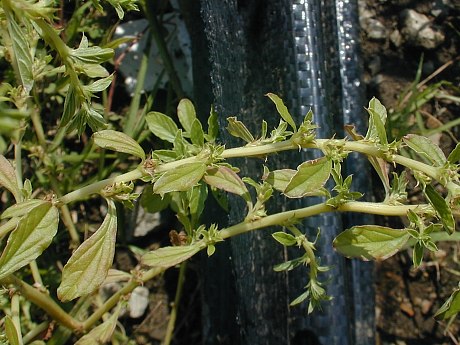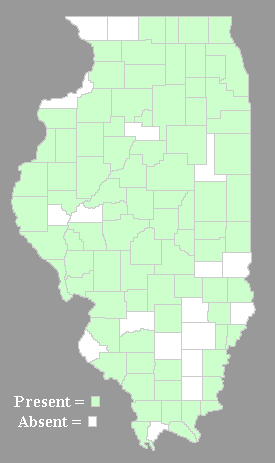Description: This plant is a summer annual about ½–2½' tall and ½–3' across. Large specimens branch frequently and have a bushy appearance; they are broader toward the bottom than the top. Small specimens are more sparsely branched and have a scraggly appearance. The stems are whitish green to white and round or slightly furrowed. The alternate leaves are up to 1" long and ¼" across; rarely are they larger than this. Both the stems and the leaves are hairless, or nearly so. The side branches often develop at right angles (90°) from the central stem. Each leaf is light green, oblanceolate, and smooth or slightly undulate along the margins. Sometimes the leaves have yellowish or reddish tints.

From the axil of
each leaf, there develops a small cluster of inconspicuous flowers.
Each flower is surrounded by 3 lanceolate bracts about 1/8" (3 mm.) in
length;
each bract has an elongated tip that is stiff. Because White Amaranth
is monoecious, there are pistillate (female) and staminate (male)
flowers. Regardless of its gender, each flower has 3 green sepals that
are lanceolate and no petals. Each pistillate flower has an ovary with
3 styles, while each staminate flower has 3 stamens. The blooming
period occurs from mid-summer to early fall and lasts about 2 months.
The flowers are wind-pollinated. Each pistillate flower develops a
single seed that is surrounded by a wrinkled membrane (utricle). This
membrane splits open around the middle to release the seed. Each small
round seed is dark reddish brown to black, shiny, and somewhat
flattened. The root system consists of a taproot. During the winter,
this plant can break off at the base and roll around in the wind,
thereby distributing the seeds. Occasionally, it forms colonies.
Cultivation:
Typical growing conditions are full sun, mesic to dry locations, and a
barren soil containing sand, gravel, or clay.

Range & Habitat:
The native White Amaranth occurs in most areas of Illinois and it is
occasional to
locally common; this plant is less common in southern Illinois.
Habitats
include dry gravel prairies, sand prairies, cropland, abandoned fields,
vacant lots, and barren areas along railroads and roads. Generally,
this plant prefers dry barren areas with scant vegetation. In Illinois,
it is primarily a railroad weed.
Faunal Associations:
The wind-pollinated flowers don't attract many insects. Various insects
feed destructively on the foliage, seeds, and other parts of White Amaranth (Amaranthus albus) and other Amaranthus spp.
(Amaranth, Pigweeds). This includes such species as seed-eating ground
beetles, flea beetles, weevils, leaf-mining larvae of Anthomyiid flies,
plant bugs, aphids, and caterpillars of Spilosoma virginica (Virginia Tiger Moth) and other moths. The Insect Table
has a more detailed list of these insect feeders. The seeds of amaranth
and pigweeds in open upland areas are eaten by the Greater Prairie
Chicken and various granivorous songbirds, including the Horned Lark,
Savannah Sparrow, Lark Sparrow, Field Sparrow, Lapland Longspur, Snow
Bunting, and Mourning Dove. The Bird Table lists these and other species that feed on the seeds of these plants.
Photographic Location:
A vacant lot near a railroad in Urbana, Illinois.
Comments:
Another common name for White Amaranth is Tumble Pigweed, or just
Tumbleweed. In the Great Plains, this weed is often blown against
fences, where it piles up; this is less common in Illinois. White
Amaranth can be distinguished from Amaranth spp.
(Amaranths) by its white stems and small light green leaves; the
foliage has a pale appearance overall. Furthermore, the side stems
often develop from the slender central stem at right angles (90°),
providing this plant with a rather awkward and angular appearance.
Other Amaranths have larger darker leaves and they usually produce
terminal spikes of flowers. An exception is Amaranthus
blitoides (Prostrate Pigweed), which produces inconspicuous
axillary flowers like White Amaranth. However, Prostrate Pigweed has
darker leaves and a prostrate or sprawling habit. Two other species
that occur along railroads, Kochia scoparia
(Kochia) and Salsola tragus (Russian Thistle), are
also tumbleweeds with a similar appearance. They tend to be somewhat
larger in size than White Amaranth (although not always) and their
leaves are linear to lanceolate. Unlike White Amaranth, Russian Thistle
is rather prickly, while Kochia has long white hairs near the flowers.
They are all members of the Amaranth family.